Definition: Scaling technique is a method of placing respondents in continuation of gradual change in the pre-assigned values, symbols or numbers based on the features of a particular object as per the defined rules. All the scaling techniques are based on four pillars, i.e., order, description, distance and origin.
The marketing research is highly dependable upon the scaling techniques, without which no market analysis can be performed.
Content: Scaling Techniques
Types of Scaling Techniques
The researchers have identified many scaling techniques; today, we will discuss some of the most common scales used by business organizations, researchers, economists, experts, etc.
These techniques can be classified as primary scaling techniques and other scaling techniques.
Let us now study each of these methods in-depth below:
Primary Scaling Techniques
The major four scales used in statistics for market research consist of the following:
Nominal Scale
Nominal scales are adopted for non-quantitative (containing no numerical implication) labelling variables which are unique and different from one another.
Types of Nominal Scales:
- Dichotomous: A nominal scale that has only two labels is called ‘dichotomous’; for example, Yes/No.
- Nominal with Order: The labels on a nominal scale arranged in an ascending or descending order is termed as ‘nominal with order’; for example, Excellent, Good, Average, Poor, Worst.
- Nominal without Order: Such nominal scale which has no sequence, is called ‘nominal without order’; for example, Black, White.
Ordinal Scale
The ordinal scale functions on the concept of the relative position of the objects or labels based on the individual’s choice or preference.
For example, At Amazon.in, every product has a customer review section where the buyers rate the listed product according to their buying experience, product features, quality, usage, etc.
The ratings so provided are as follows:
- 5 Star – Excellent
- 4 Star – Good
- 3 Star – Average
- 2 Star – Poor
- 1 Star – Worst
Interval Scale
An interval scale is also called a cardinal scale which is the numerical labelling with the same difference among the consecutive measurement units. With the help of this scaling technique, researchers can obtain a better comparison between the objects.
For example; A survey conducted by an automobile company to know the number of vehicles owned by the people living in a particular area who can be its prospective customers in future. It adopted the interval scaling technique for the purpose and provided the units as 1, 2, 3, 4, 5, 6 to select from.
In the scale mentioned above, every unit has the same difference, i.e., 1, whether it is between 2 and 3 or between 4 and 5.
Ratio Scale
One of the most superior measurement technique is the ratio scale. Similar to an interval scale, a ratio scale is an abstract number system. It allows measurement at proper intervals, order, categorization and distance, with an added property of originating from a fixed zero point. Here, the comparison can be made in terms of the acquired ratio.
For example, A health product manufacturing company surveyed to identify the level of obesity in a particular locality. It released the following survey questionnaire:
Select a category to which your weight belongs to:
Less than 40 kilograms
- 40-59 Kilograms
- 60-79 Kilograms
- 80-99 Kilograms
- 100-119 Kilograms
- 120 Kilograms and more
The following table will better clarify the difference between all the four primary scaling techniques:
| Particular | Nominal Scale | Ordinal Scale | Interval Scale | Ratio Scale |
|---|---|---|---|---|
| Characteristics | Description | Order | Distance | Description, Order, Distance and Origin |
| Sequential Arrangement | Not Applicable | Applicable | Applicable | Applicable |
| Fixed Zero Point | Not Applicable | Not Applicable | Not Applicable | Applicable |
| Multiplication and Division | Not Applicable | Not Applicable | Not Applicable | Applicable |
| Addition and Subtraction | Not Applicable | Not Applicable | Applicable | Applicable |
| Difference between Variables | Non-Measurable | Non-Measurable | Measurable | Measurable |
| Mean | Not Applicable | Not Applicable | Applicable | Applicable |
| Median | Not Applicable | Applicable | Applicable | Applicable |
| Mode | Applicable | Applicable | Applicable | Applicable |
Other Scaling Techniques
Scaling of objects can be used for a comparative study between more than one objects (products, services, brands, events, etc.). Or can be individually carried out to understand the consumer’s behaviour and response towards a particular object.
Following are the two categories under which other scaling techniques are placed based on their comparability:
Comparative Scales
For comparing two or more variables, a comparative scale is used by the respondents. Following are the different types of comparative scaling techniques:
Paired Comparison
A paired comparison symbolizes two variables from which the respondent needs to select one. This technique is mainly used at the time of product testing, to facilitate the consumers with a comparative analysis of the two major products in the market.
To compare more than two objects say comparing P, Q and R, one can first compare P with Q and then the superior one (i.e., one with a higher percentage) with R.
For example, A market survey was conducted to find out consumer’s preference for the network service provider brands, A and B. The outcome of the survey was as follows:
Brand ‘A’ = 57%
Brand ‘B’ = 43%
Thus, it is visible that the consumers prefer brand ‘A’, over brand ‘B’.
Rank Order
In rank order scaling the respondent needs to rank or arrange the given objects according to his or her preference.
For example, A soap manufacturing company conducted a rank order scaling to find out the orderly preference of the consumers. It asked the respondents to rank the following brands in the sequence of their choice:
| Soap Brands | Rank |
|---|---|
| Brand V | 4 |
| Brand X | 2 |
| Brand Y | 1 |
| Brand Z | 3 |
The above scaling shows that soap ‘Y’ is the most preferred brand, followed by soap ‘X’, then soap ‘Z’ and the least preferred one is the soap ‘V’.
Constant Sum
It is a scaling technique where a continual sum of units like dollars, points, chits, chips, etc. is given to the features, attributes and importance of a particular product or service by the respondents.
For example, The respondents belonging to 3 different segments were asked to allocate 50 points to the following attributes of a cosmetic product ‘P’:
| Attributes | Segment 1 | Segment 2 | Segment 3 |
|---|---|---|---|
| Finish | 11 | 8 | 9 |
| Skin Friendly | 11 | 12 | 12 |
| Fragrance | 7 | 11 | 8 |
| Packaging | 9 | 8 | 10 |
| Price | 12 | 11 | 11 |
From the above constant sum scaling analysis, we can see that:
- Segment 1 considers product ‘P’ due to its competitive price as a major factor.
- But segment 2 and segment 3, prefers the product because it is skin-friendly.
Q-Sort Scaling
Q-sort scaling is a technique used for sorting the most appropriate objects out of a large number of given variables. It emphasizes on the ranking of the given objects in a descending order to form similar piles based on specific attributes.
It is suitable in the case where the number of objects is not less than 60 and more than 140, the most appropriate of all ranging between 60 to 90.
For example, The marketing manager of a garment manufacturing company sorts the most efficient marketing executives based on their past performance, sales revenue generation, dedication and growth.
The Q-sort scaling was performed on 60 executives, and the marketing head creates three piles based on their efficiency as follows:

In the above diagram, the initials of the employees are used to denote their names.
Non-Comparative Scales
A non-comparative scale is used to analyse the performance of an individual product or object on different parameters. Following are some of its most common types:
Continuous Rating Scales
It is a graphical rating scale where the respondents are free to place the object at a position of their choice. It is done by selecting and marking a point along the vertical or horizontal line which ranges between two extreme criteria.
For example, A mattress manufacturing company used a continuous rating scale to find out the level of customer satisfaction for its new comfy bedding. The response can be taken in the following different ways (stated as versions here):
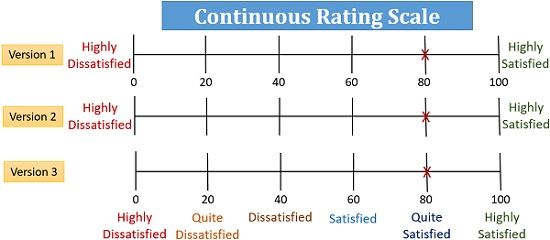
The above diagram shows a non-comparative analysis of one particular product, i.e. comfy bedding. Thus, making it very clear that the customers are quite satisfied with the product and its features.
Itemized Rating Scale
Itemized scale is another essential technique under the non-comparative scales. It emphasizes on choosing a particular category among the various given categories by the respondents. Each class is briefly defined by the researchers to facilitate such selection.
The three most commonly used itemized rating scales are as follows:
- Likert Scale: In the Likert scale, the researcher provides some statements and ask the respondents to mark their level of agreement or disagreement over these statements by selecting any one of the options from the five given alternatives.
For example, A shoes manufacturing company adopted the Likert scale technique for its new sports shoe range named Z sports shoes. The purpose is to know the agreement or disagreement of the respondents.
For this, the researcher asked the respondents to circle a number representing the most suitable answer according to them, in the following representation:- 1 – Strongly Disagree
- 2 – Disagree
- 3 – Neither Agree Nor Disagree
- 4 – Agree
- 5 – Strongly Agree
| Statement | Strongly Disagree | Disagree | Neither Agree Nor Disagree | Agree | Strongly Agree |
|---|---|---|---|---|---|
| Z sports shoes are very light weight | 1 | 2 | 3 | 4 | 5 |
| Z sports shoes are extremely comfortable | 1 | 2 | 3 | 4 | 5 |
| Z sports shoes look too trendy | 1 | 2 | 3 | 4 | 5 |
| I will definitely recommend Z sports shoes to friends, family and colleagues | 1 | 2 | 3 | 4 | 5 |
The above illustration will help the company to understand what the customers think about its products. Also, whether there is any need for improvement or not.
- Semantic Differential Scale: A bi-polar seven-point non-comparative rating scale is where the respondent can mark on any of the seven points for each given attribute of the object as per personal choice. Thus, depicting the respondent’s attitude or perception towards the object.
For example, A well-known brand for watches, carried out semantic differential scaling to understand the customer’s attitude towards its product. The pictorial representation of this technique is as follows:
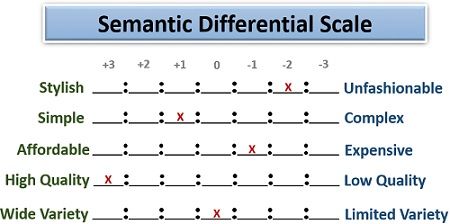
From the above diagram, we can analyze that the customer finds the product of superior quality; however, the brand needs to focus more on the styling of its watches.
- Stapel Scale: A Stapel scale is that itemized rating scale which measures the response, perception or attitude of the respondents for a particular object through a unipolar rating. The range of a Stapel scale is between -5 to +5 eliminating 0, thus confining to 10 units.
For example, A tours and travel company asked the respondent to rank their holiday package in terms of value for money and user-friendly interface as follows:
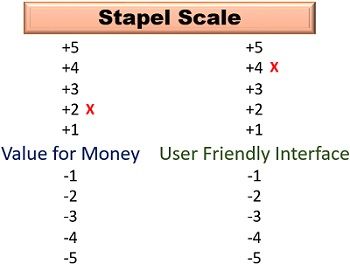
With the help of the above scale, we can say that the company needs to improve its package in terms of value for money. However, the decisive point is that the interface is quite user-friendly for the customers.
Conclusion
Scaling techniques provide a clear picture of the product life cycle and the market acceptability of the products offered. It facilitates product development and benchmarking through rigorous market research.
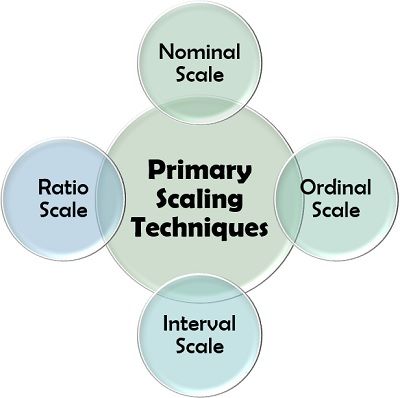
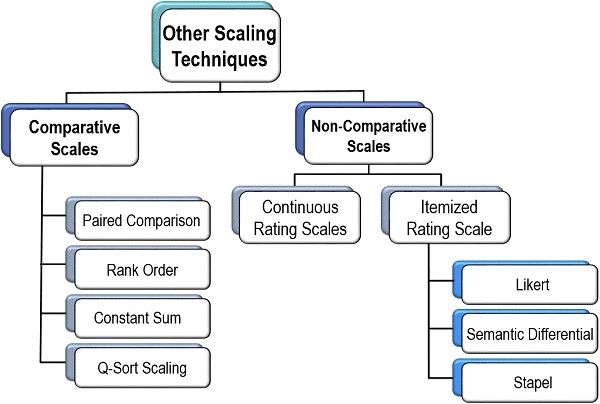
Monika says
Thanku so much for providing this valuable notes for free of cost
anonymous says
Thnaks mate
Rina says
Very helpful notes really… Tqsomch dear God bless uhhh from bottom of my heart ❤️ 🙏🙏
Nazra Parveen says
This notes are very beneficial for me during exam days . understandable or meaningful. Thank u so much… for Free of cost service .